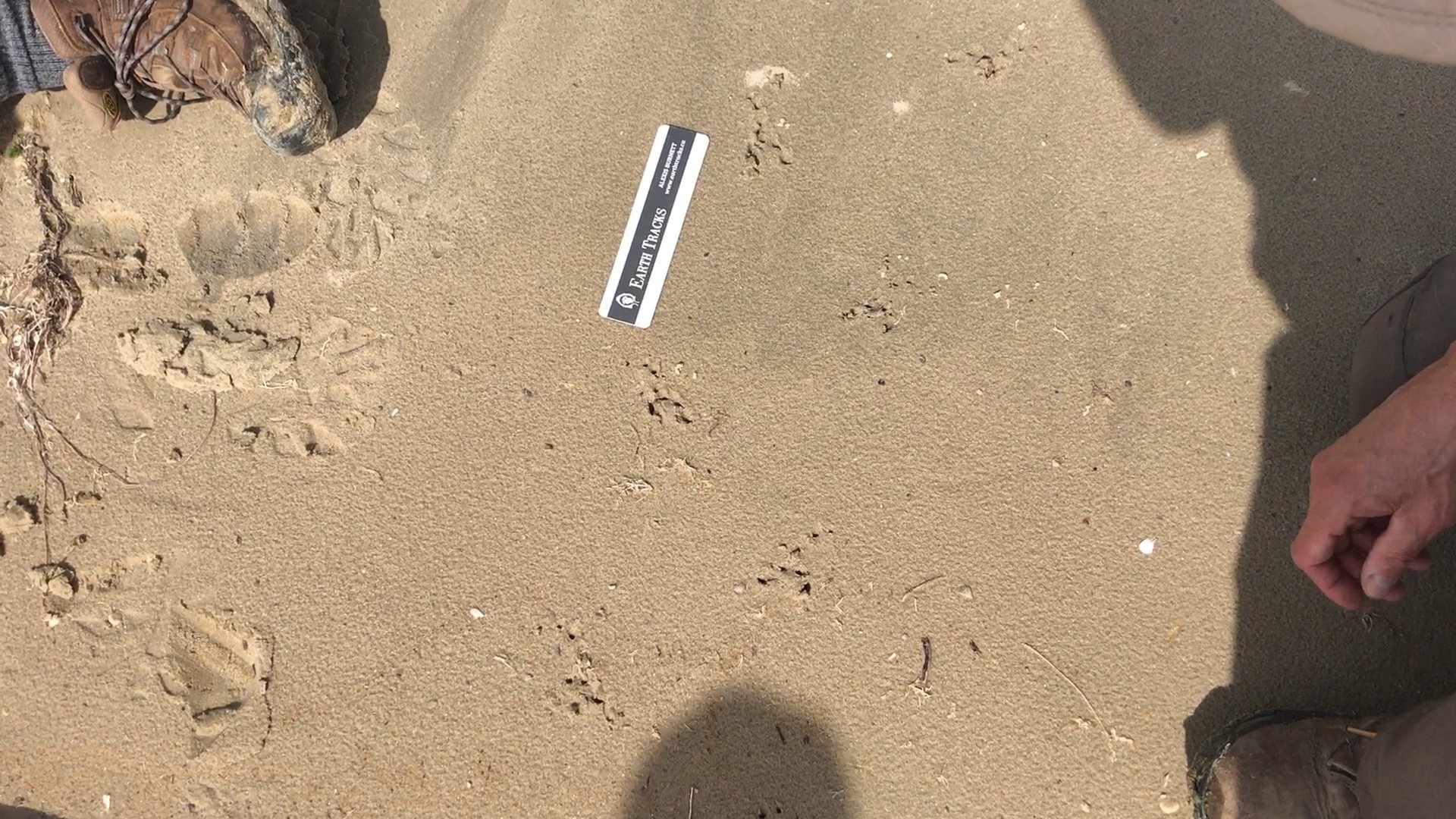Tracking at Saugeen Shores, 2024.09.28
The most recent outing with the Earth Tracks tracking apprenticeship group was too much. I can’t even figure out what to start writing about. Maybe it should be about the Northern Harriers (Circus hudsonius) we saw swooping low over the grasses and sedges out along the peninsula? Or maybe the Sandhill Cranes (Antigone canadensis) and Great Blue Heron (Ardea herodias) wading out across the small inlet. I think I’ll start with the confusing ones…
When the apprenticeship visited the Saugeen Shores, I got confused. How do we tell the difference between Sandhill Crane tracks and Wild Turkey (Meleagris gallopavo) tracks? I am sure it is simple to some folks, but I still get mixed up every time I encounter either of their tracks where species could overlap in the same habitat.
Let’s start with my quick measurements. I sadly only wrote down one length measurement and that was 8 cm. The widths I wrote down were 9.5, 11.5 and 12 cm. While the length measurement does not fit for either Wild Turkey and the Sandhill Crane according to Elbroch and Marks, the widths do. Some of the tracks I thought I could make out a hallux, or toe 1, but I wasn’t sure as there were many of the same track in the area, often overlapping one another.

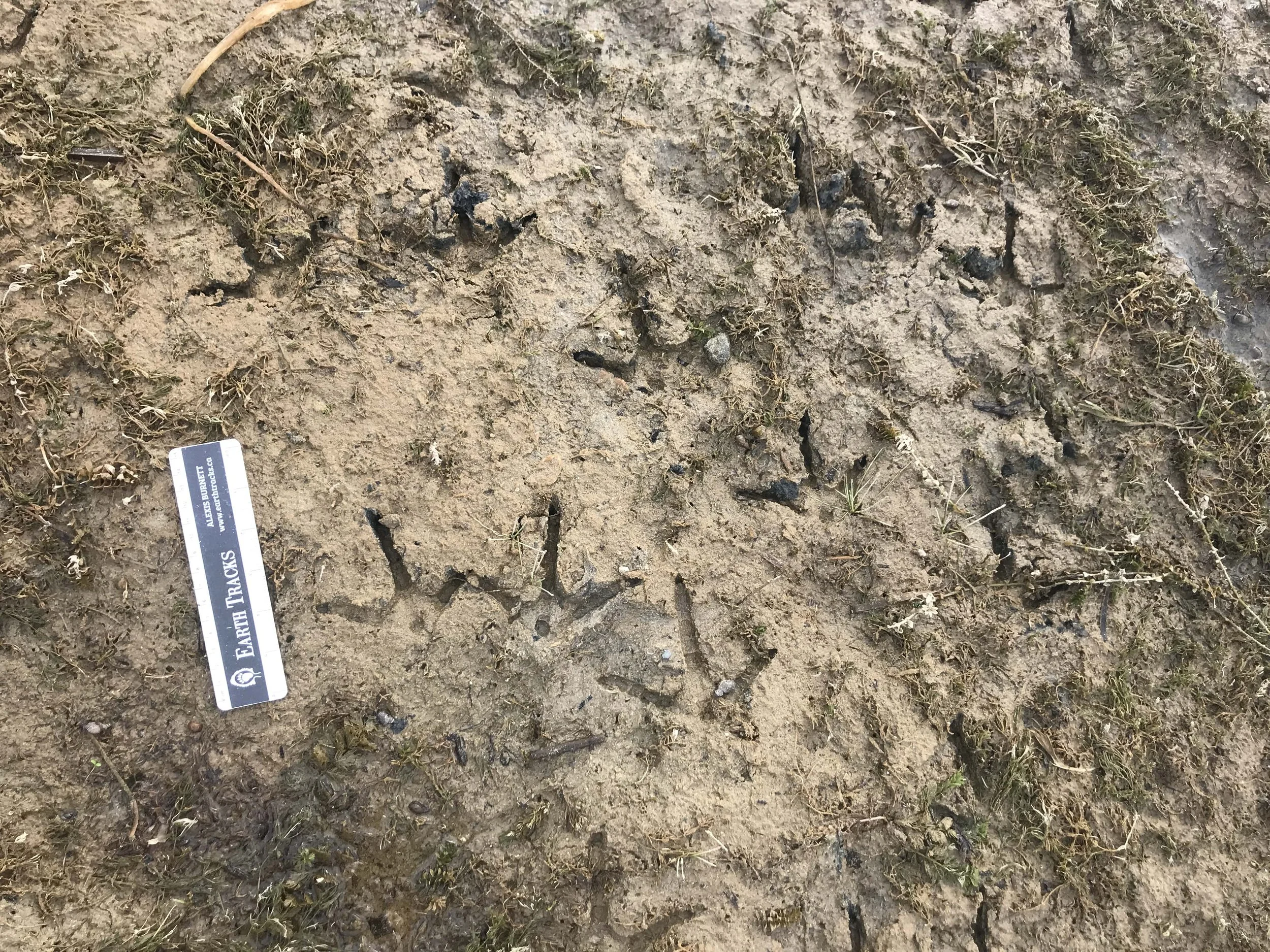
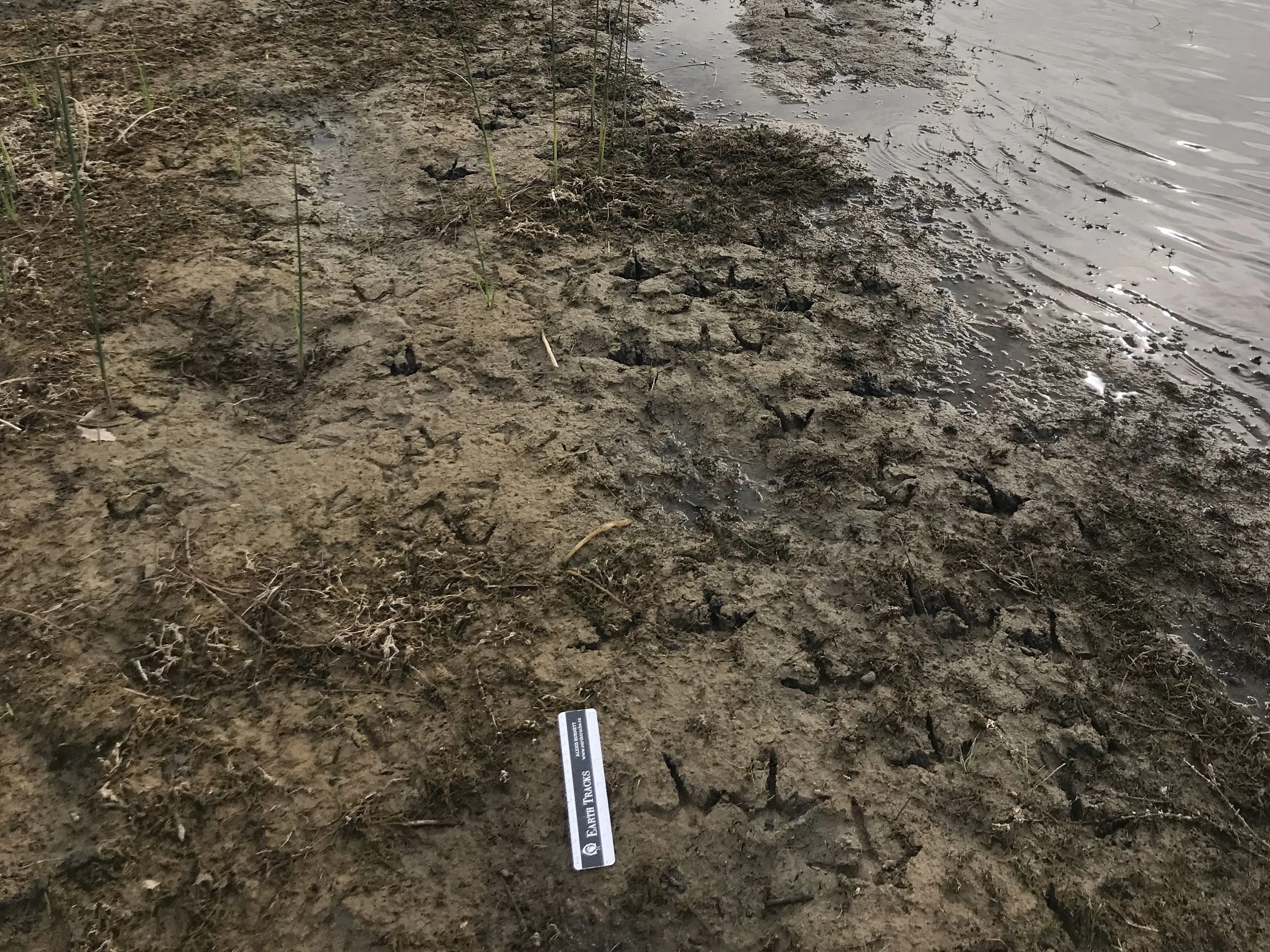
A couple of things began to take shape in my mind which helped me clarify who these tracks belonged to. First was the bulbousness of the toes, especially noticeable in toe 3 (the long middle toe). This is something I don’t seem to see as much in the Sandhill Cranes, who have fairly slender toes which leave a smooth toe look in the track. This bulbousness tends to be consistent with the Wild Turkey. I also noticed the hallux (toe 1, which points backwards, or towards the bottom of the photo above) on many of the tracks. They were sometimes faint, and sometimes I was uncertain if they registered, but I saw them. The stride length appeared short, and if you can imagine a Sandhill Crane’s legs compared to a Wild Turkey, the shorter strides match the shorter legs of the Turkey. Lastly, there were so many tracks pursuing a few different trails that I had to go with Wild Turkey. I don’t believe I have ever seen more than three Sandhill Cranes in a given spot at a time. I know they do crew up in large groups for migration (which for the Autumn migration it is usually from mid-late October to late November), but we had only seen two an hour or so before on the far side of a bay on the far side of the peninsula we were on.
All in all, Sandhill Crane didn’t seem as likely creators in light of all the other factors mentioned above. Instead I believe the tracks were made by a mixed group of older and younger (considering length of some of the tracks) Wild Turkeys.
These weren’t the only bird tracks we saw…
Edited photo of Greater Yellowlegs we saw taken through my monocular (photo edited for better display online).
I first noticed the Greater Yellowlegs (Tringa melanoleuca) calls before seeing them. They reminded me of a Killdeer (Charadrius vociferus) call in timbre and frenetic energy, but different in cadence and length. We were on the beach where I had just been looking at Killdeer tracks moments before and wondered if it was them, but when they were pointed out later it made more sense that these were the Greater Yellowlegs based on their size. When I got out the monocular my eye was attracted to their long bill and airfoil-ish, football-like, body shape.
Andy and I watched two of the Yellowlegs run and stutter about in the shallow water of a narrow shallow channel running between estuaries at the edge of Lake Huron. We waited until they had made their way around a small sand bar and when they did we went over to where they had just been in search of tracks.
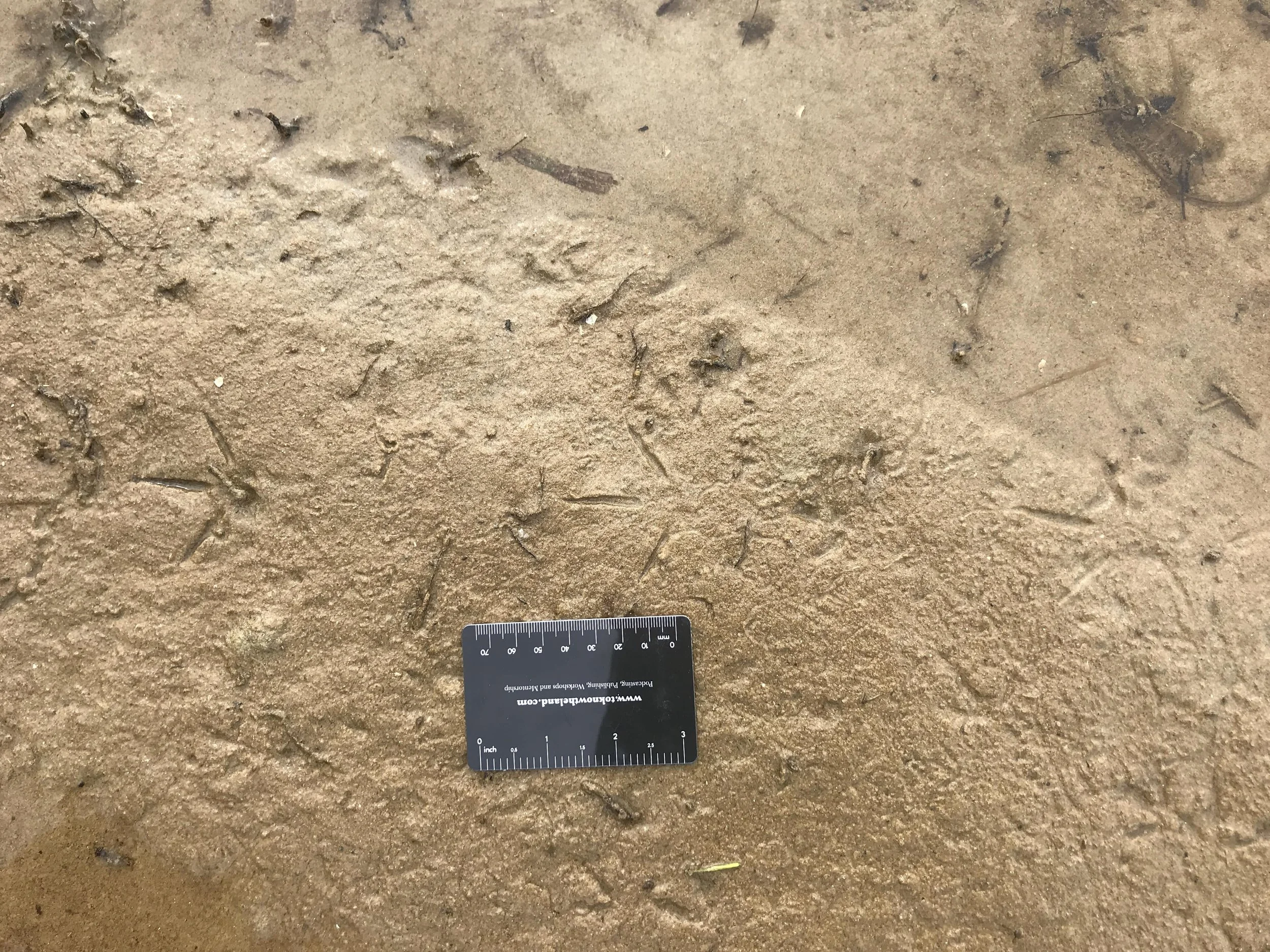
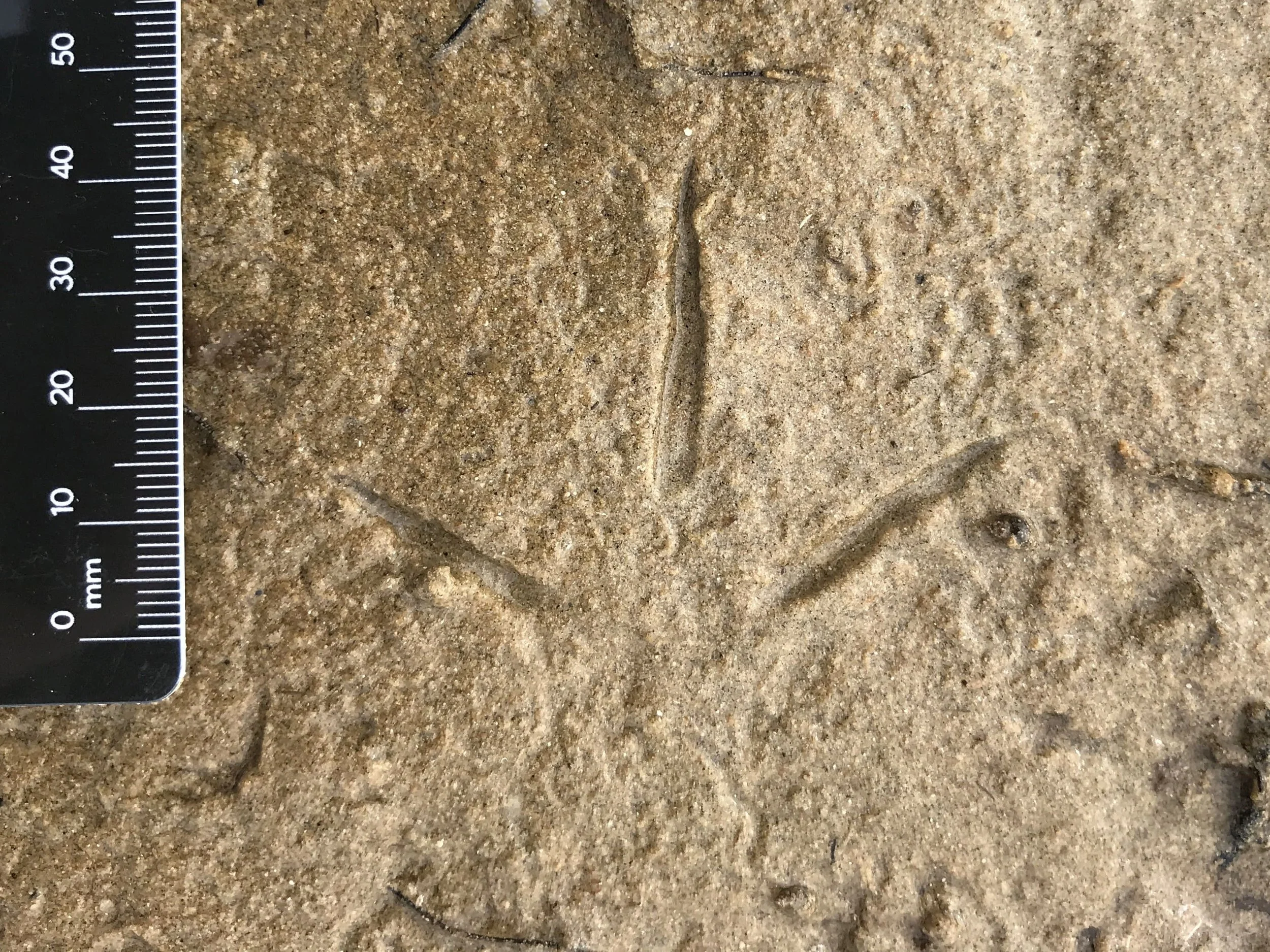

It took us a second to figure out where the Yellowlegs had just walked but we found a small trail from where they had come up, out of the deeper stream, up to the muddy sand. Yellowlegs, being in the Scolopacidae should leave a halux of some kind in their tracks, but the first series we found seemed to lack a visible hallux (later we did find some tracks with a small dot impressed in the sand from the hallux). I took out the ruler and measured them. 4.5 L x 6.2 cm W (1¾ in L x 2½ in W). Mark Elbroch and Eleanor Marks give the dimensions for the Greater Yellowlegs tracks as 4.1 - 4.7 cm L (1⅝ - 1⅞ in L) x 5.7 - 6.7 cm W (2¼ - 2⅝ in W). They describe the track as “Incumbent foot structure. Webbing is present between toes 3 and 4… the metatarsal does not show unless the substrate is deep. Toes appear very slim in track registrations.” These descriptions seemed to fit well, but I struggled to see the webbing and the hallux was not reliably registering. Perhaps this is a matter of substrate?
Greater Yellowlegs tracks are similar to Spotted Sandpiper tracks, which come in at small 2.2 - 2.5 cm (⅞ - 1 in) L by 2.5 - 3.2 cm (1 - 1¼ in) W, which is a noticeably smaller. Jonathan Poppele says the same as Elbroch and Marks, that the metatarsal will rarely show on the Yellowlegs, but does tend to show up on the Spotted Sandpiper. Good to keep these in mind in case I see either of these two in the future.
The Yellowlegs tracks kept us busy for a while, but we kept going as we had so much more to explore. I walked back to grab my bag and revisit something else I had taken a look at earlier. Some skeletal remains of some sort of fish. A couple of the bones we found looked like they could be a spinal column. A couple looked like saw blades and we even cut some sedges with them, just to see how well they would cut. Some I couldn’t figure out at all. And then there were a couple which struck me both as familiar and as very strange. Two identical bones, the same bone yet likely situated opposite each other in the body, curved with small tooth-like tubercles or nodules on them. Here are some photos, one from the day of, and some taken later in my backyard.
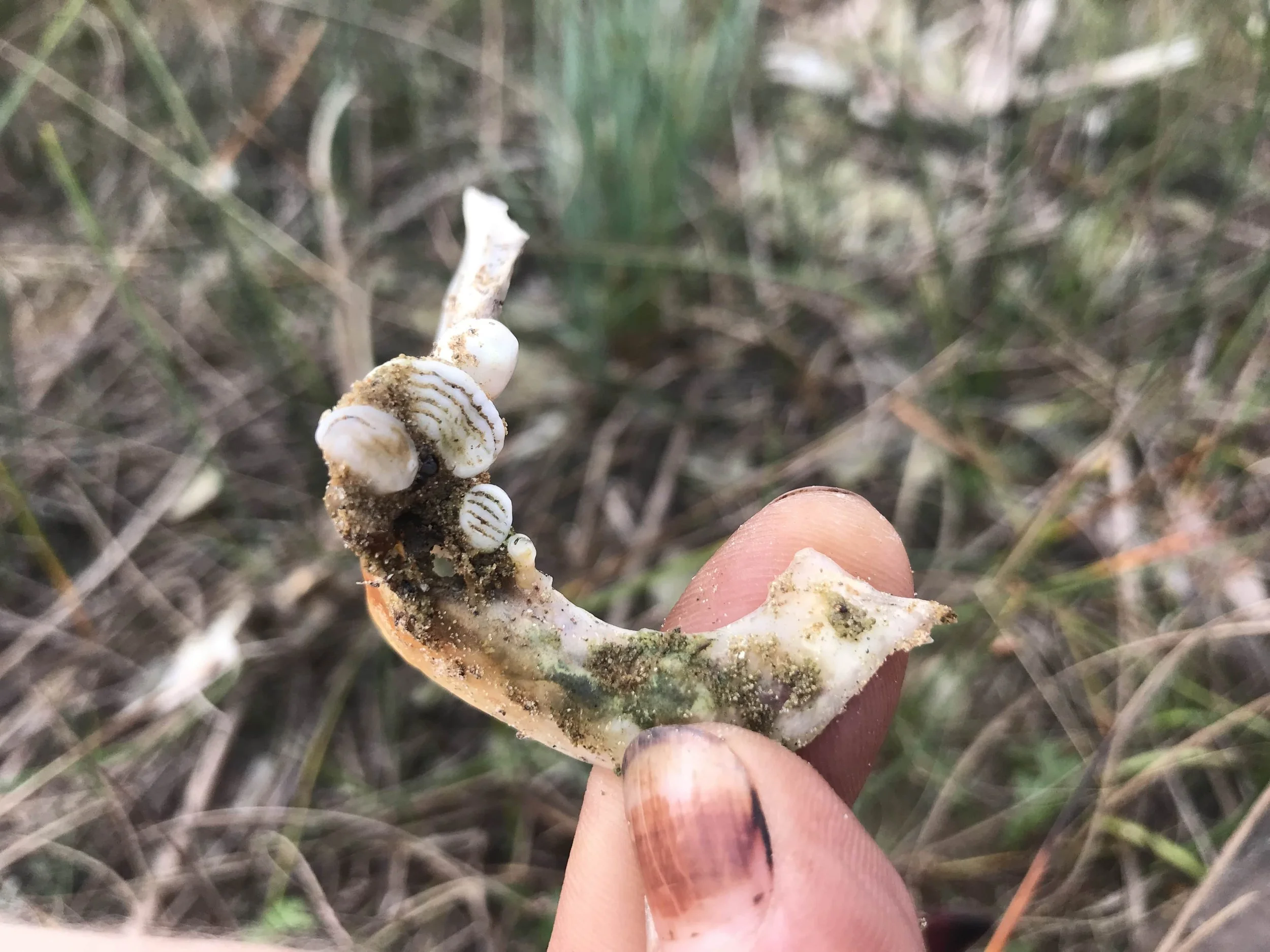

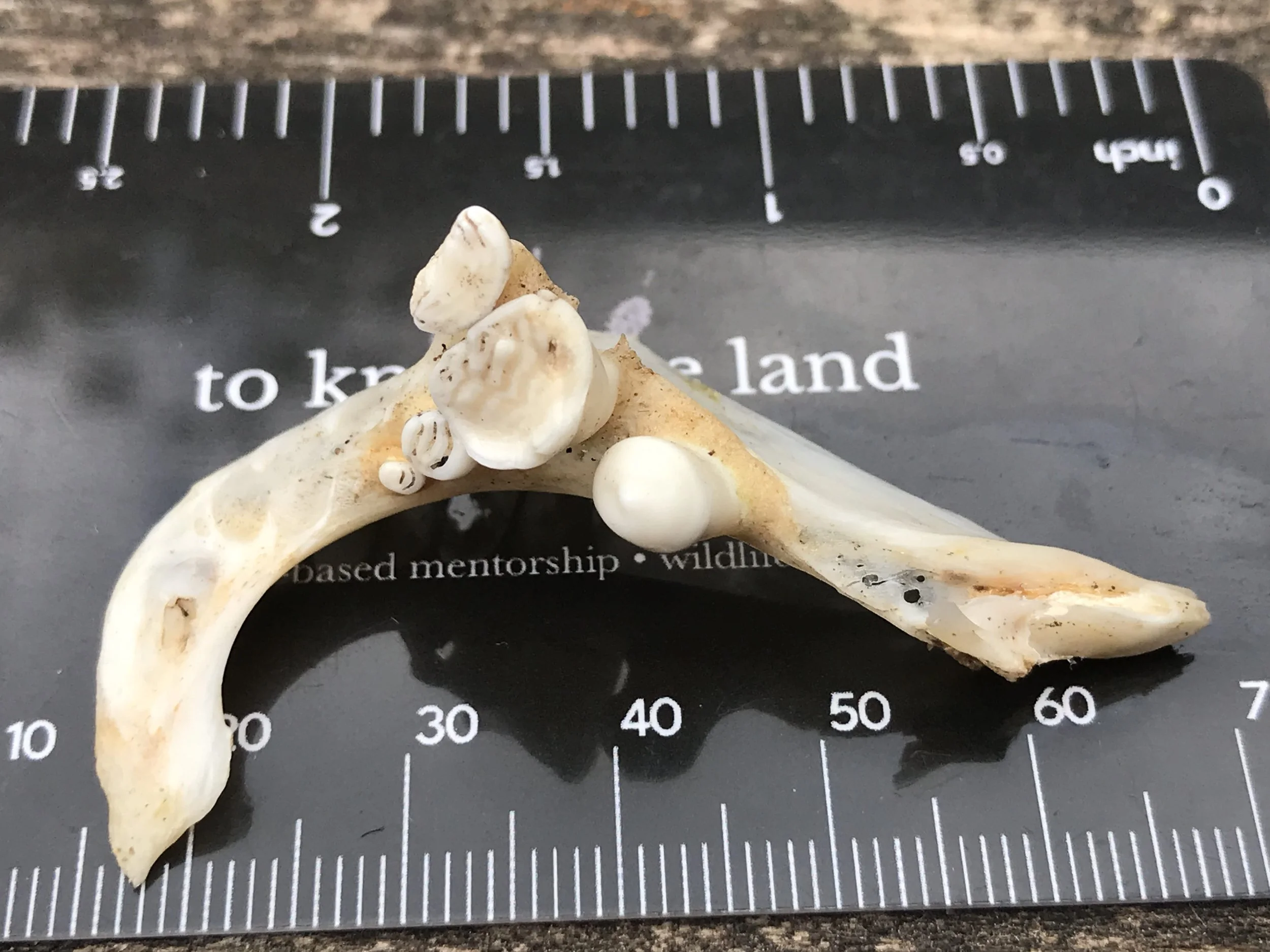
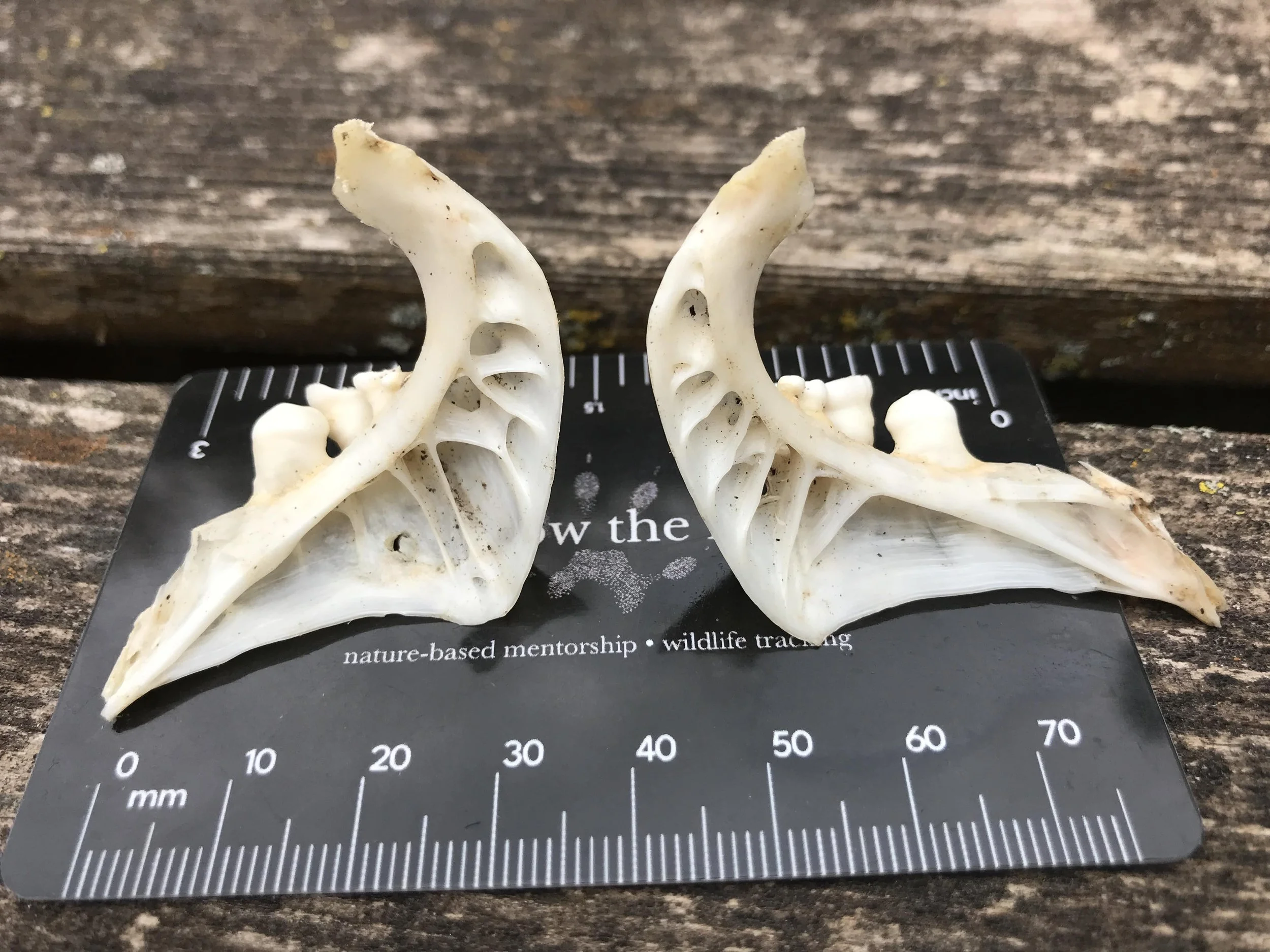
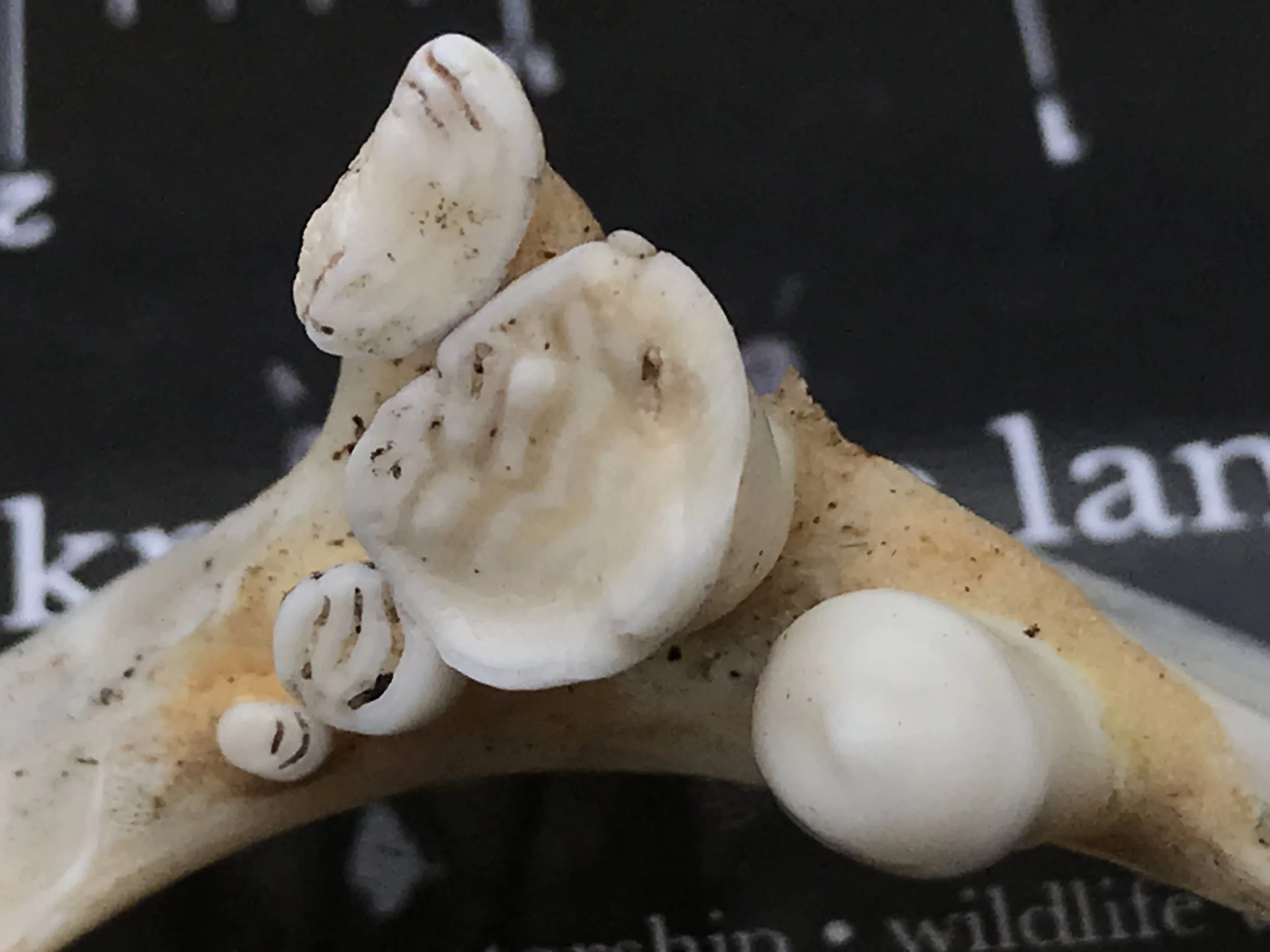
These were definitely familiar, but I couldn’t remember exactly what they were for. Someone had explained it to me a while ago, but it just didn’t stick. So I looked it up. Let’s start with the basics.
Gill filaments and gill rakers on a Rainbow Trout (Oncorhynchus mykiss).
Most fish have gills. Some have lungs, but we’re going to discuss the gills so I am going to stay on point. How do gills work? Well the fish draw in oxygenated water in through their mouth. They then pump this water over the gill filaments so oxygen can enter the bloodstream. These same gill filaments also allow oxygen poor water to leave through the same gill slit.
Most bony fish have five boney gill arches, sometimes called branchial arches, on each side of their heads. The gill arches support the gill rakers on the anterior side (closer to the front of the fish) and gill filaments on the posterior part (closer to the tail). Gill filaments again are where gas exchange occurs. The gill rakers are little protrusions which “rake up” small particulate which can be consumed by the fish and may also be for prey retention in the case of a fish consuming smaller stuff. Think of them both as filters, one for gas, the other for food.
1,1,3-3,1,1 dental formula of the European Carp, counting from the outside in on the near gill arch, and then the inside out on the far gill arch.
For some fish, the fifth gill arch is modified. There are no gill filaments. Instead there are boney tubercles are called pharyngeal teeth. These pharangyal teeth are probably modified gill rakers which have evolved to serve a new function. They sit in the back of the throat of a few different fish species. They aren’t teeth anatomically, but they serve a lot of the same function as teeth do. They help fish to crush and break down small mollusks and crustaceans or even tough vegetation that they are consuming as well as help to filter whatever is going down their throats. Based on the size of the teeth and the other bones we found, I think we identified this individual as a carp.
Carps are in the family Cyprinidae which also include chub, dace, shiners, true minnows, koi, and Goldfish (Carassius auratus). They all lack oral teeth but they do have pharyngeal teeth (as do some other families as well), and these pharyngeal teeth display with such diversity that they can be used to identify different species. There are even pharyngeal teeth formula to help with this identification, but for now I only know the this individual species dental formula : 1, 1, 3 : 3, 1, 1, counting from the outside in on the near gill arch, and then the inside out on the far gill arch. Based on the teeth we found, I am going to call this fish a European Carp (Cyprinus carpio), also known as the Common Carp. They are a non-native species which loves the warmer vegetated shallows of the Great Lakes and many of the rivers which spill into them, such as the Eramosa River where I live. European Carp teeth have been described as having the same 1, 1, 3:3, 1,1 dental formula, and the teeth themselves are “robust, molar-like with crown flattened or somewhat furrowed”. Still no idea how they died and wash up on the beach, but they were there, picked clean, likely by some of the birds in the area as few bones which were present were broken, which is pretty common sign for mammals scavenging.
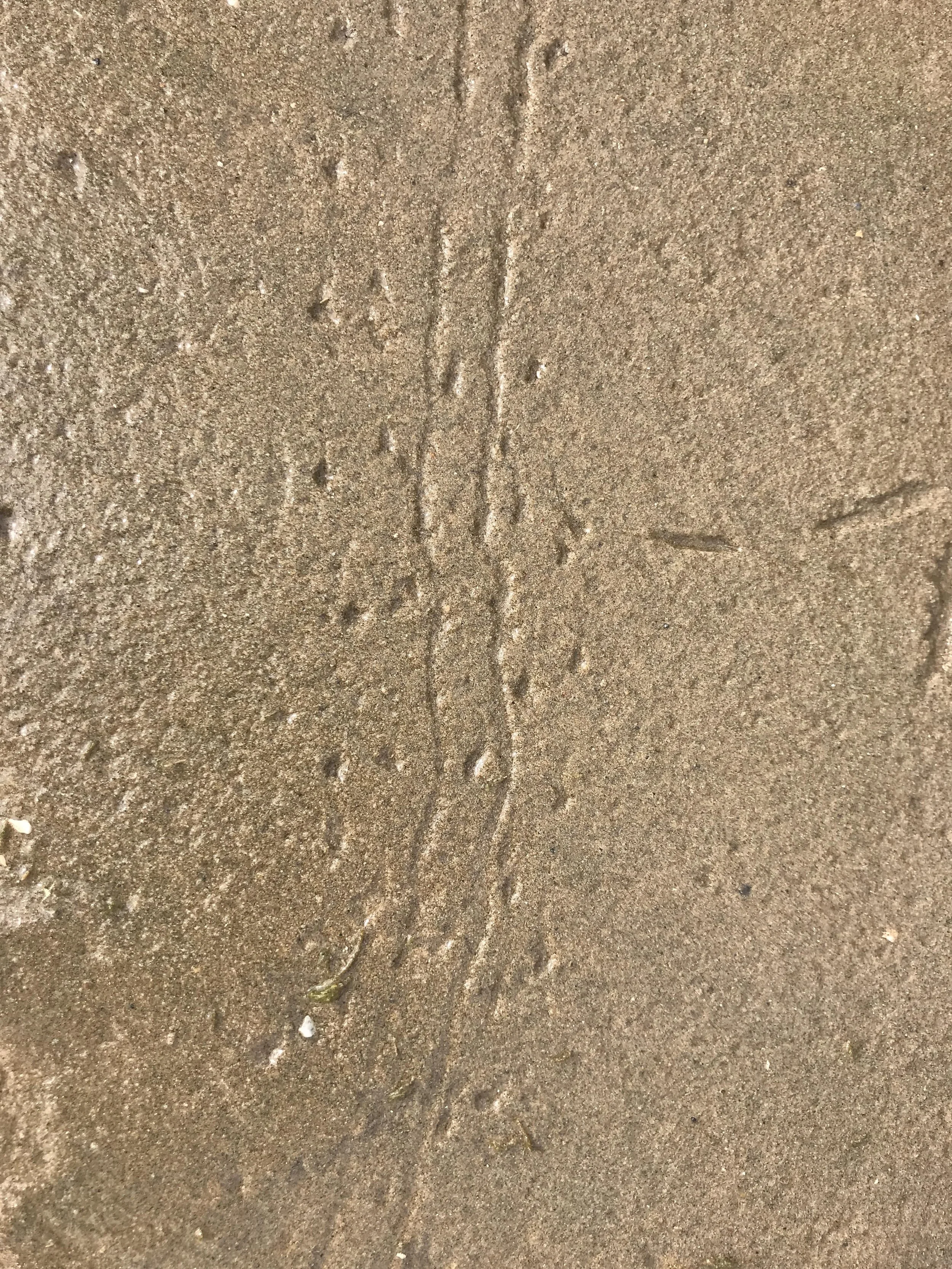

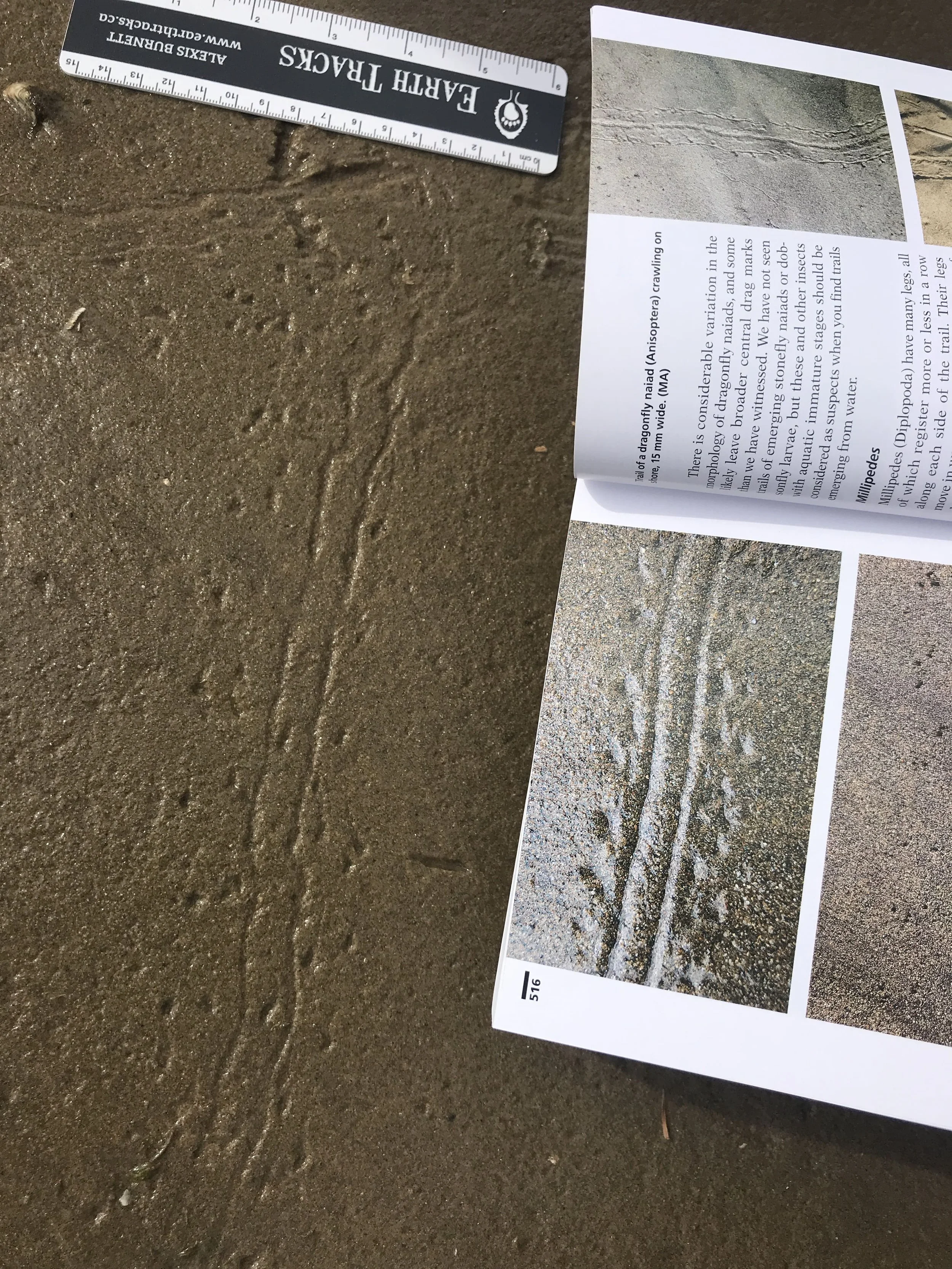
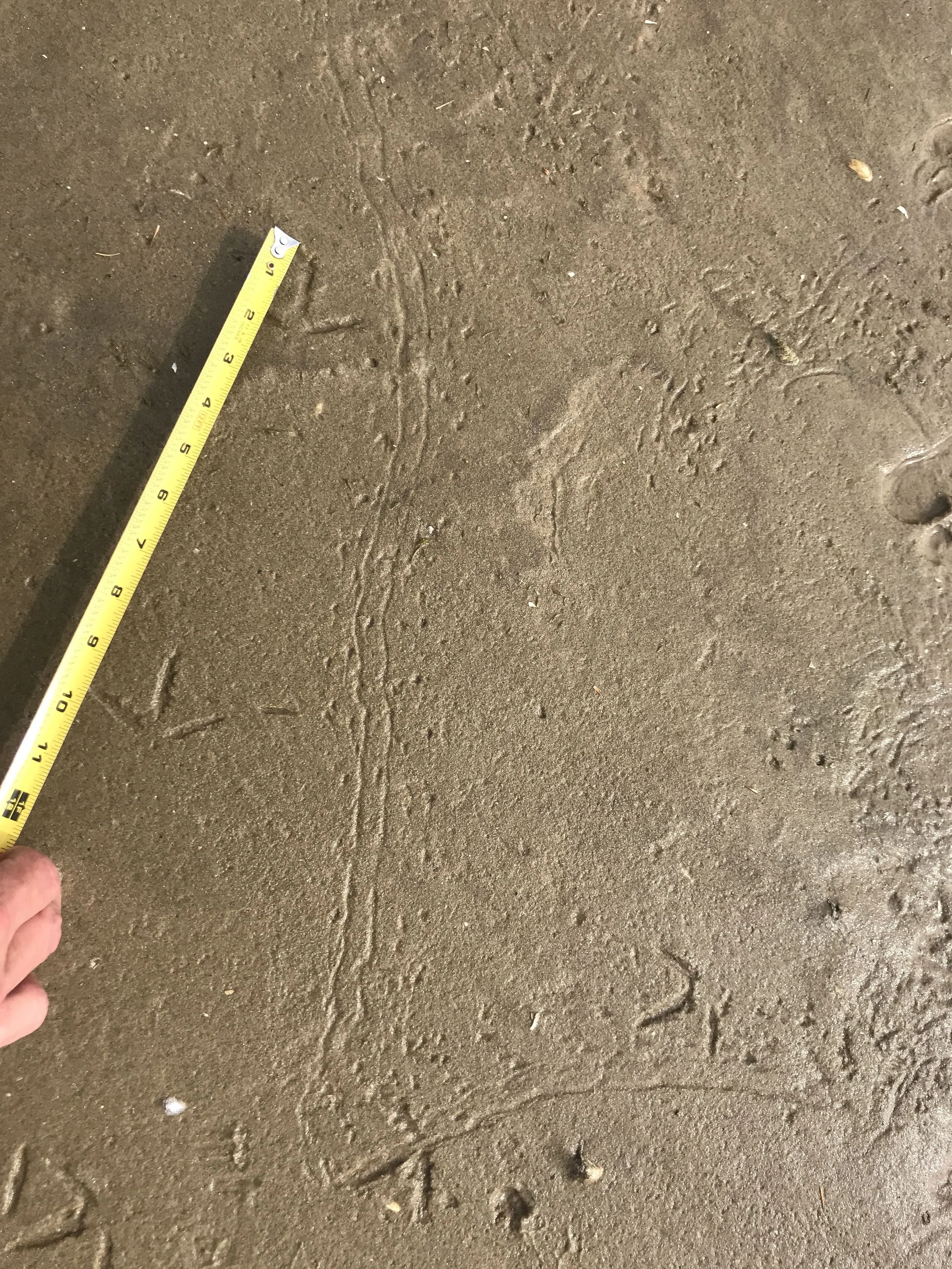
Close to the second European Carp skull we found, yes we found a couple, there was a really cool trail in the soft wet sand, which I had only seen in books and in photos online, but never in person. The trail appeared as two distinct lines running parallel each other, holding a constant width of 14 mm wide. Outside of these two lines were patterns of dots, sometimes repeating and regular, and sometimes out of sync with one another. The constant width of the trail is important. I interpret this to be caused by a body that cannot get any narrower, or wider. It tells me that mechanically, the body, or a part of the body of the animal that made this trail is in a fixed width. Someone in our group identified this trail fairly quickly as belonging to a crayfish of some kind. We pulled out Tracks and Sign of Insects and Other Invertebrates by Charley Eiseman and Noah Charney and flipped through until we found the right page. Looked like a match.
The thin drag marks left by the outer edges of the tail projections (called uropods) are usually an obvious distinguishing feature of crayfish (Astacoidea) trails. Trails appear as two well-spaced parallel lines, with tracks from the legs registering outside these lines. Crayfish walk primarily on the four pairs of legs (periopods 2 through 5) behind their claws (periopod 1), the first two of which have two fingers at the end that form small pincers. Tracks often register in groups of three or four, depending on whether the last pair of legs leaves distinguishable imprints… On good substrates, the pincers on each of the front two leg pairs register as two distinct dots.
Looks right, sounds right, but I wish I could know the direction of travel. From looking at the drag marks in the dots, again created by the legs, I believe that the crayfish was heading from the top of the image towards the bottom of the image. Why do I think this? Remember snow? Well, when say a White-tailed Deer (Odocoileus virginianus) or a Coyote (Canis latrans) is moving through the snow I often see a slope descending from where the animal is moving forward and about to put their foot down, and then a sharp lift out of the deep snow with incredibly little to no ascending slope at all. While this sand was not deep snow, I believe the same results happen in various substrates, even with different types of bodies creating the marks.
Another cool invertebrate trail we found looked muddy and as if little bits of sand had been pushed up from below to form a crumbling esker, like a tiny mole tunnel. We were looking at it wondering who could have made it when I remembered Shane Hawkins saying she once found a spot where a Common Snapping Turtle (Chelydra serpentina) trail suddenly ended in a strange muddy oval-circle shape. She wondered if the turtle had dug themselves in so she started to dig, and to her amazement, she found the resting turtle deep in the mud. I knew this wasn’t a turtle trail but decided it would be worthwhile to try and dig throughout a neighbouring tunnel and see if I could find something living inside it. And I did!
I dug out a small, maybe 22 mm long, wet, soft, squishy larvae which immediately reminded me of a firefly larva with it’s strange somewhat segmented abdominal terga plates, extending and retracting head. Firefly are in the Coleoptera order (beetles) and this little dude looked a lot like a beetle larva so that was my first guess. It isn’t a very useful guess though. Coleoptera make up about 40% of all known insect species, and about 25% of animal life on Earth. To put it another way, 1 of every 4 species of animal on Earth is a beetle. So it could be a beetle or it could be an larva that looks somewhat similar.
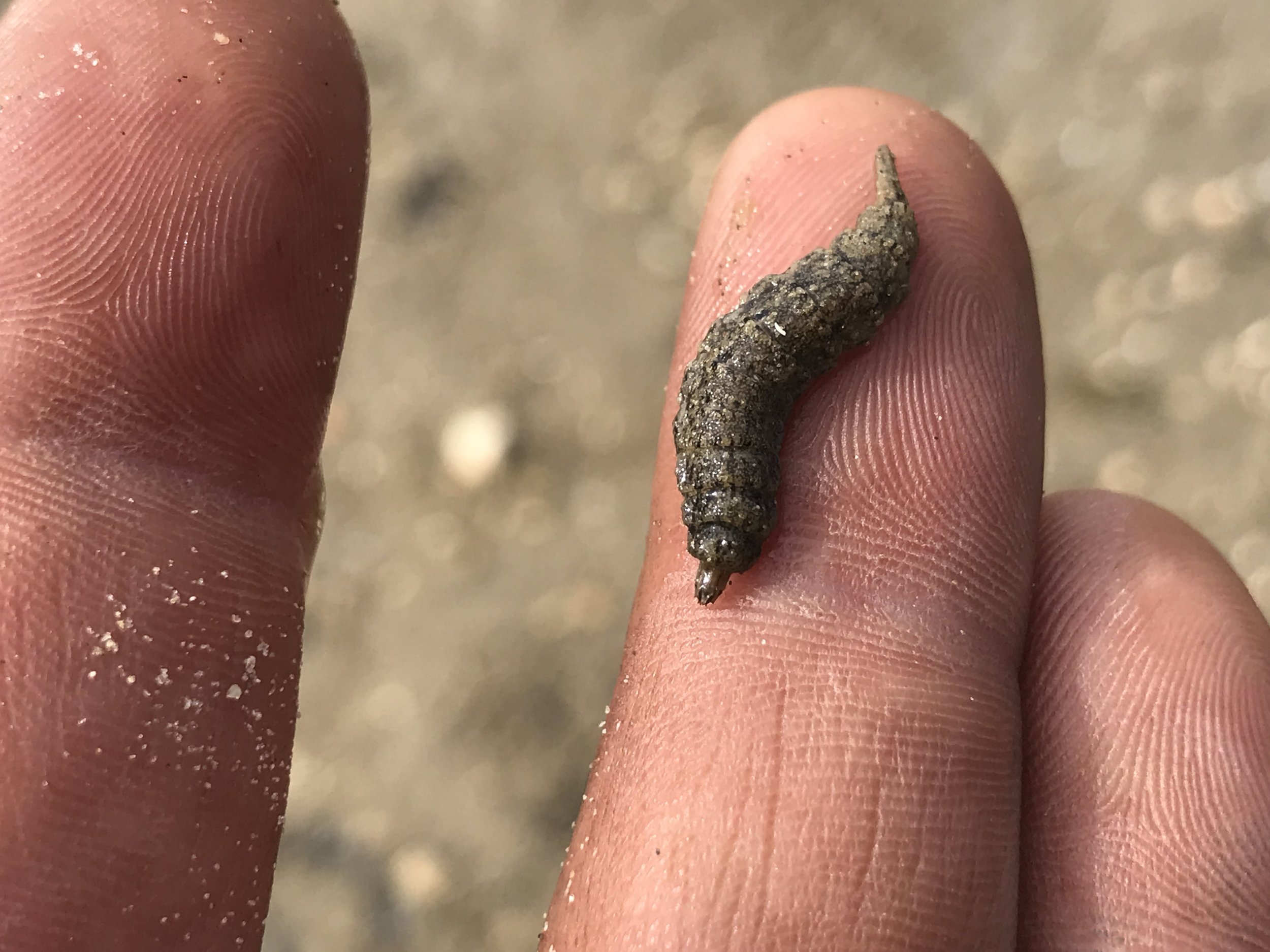
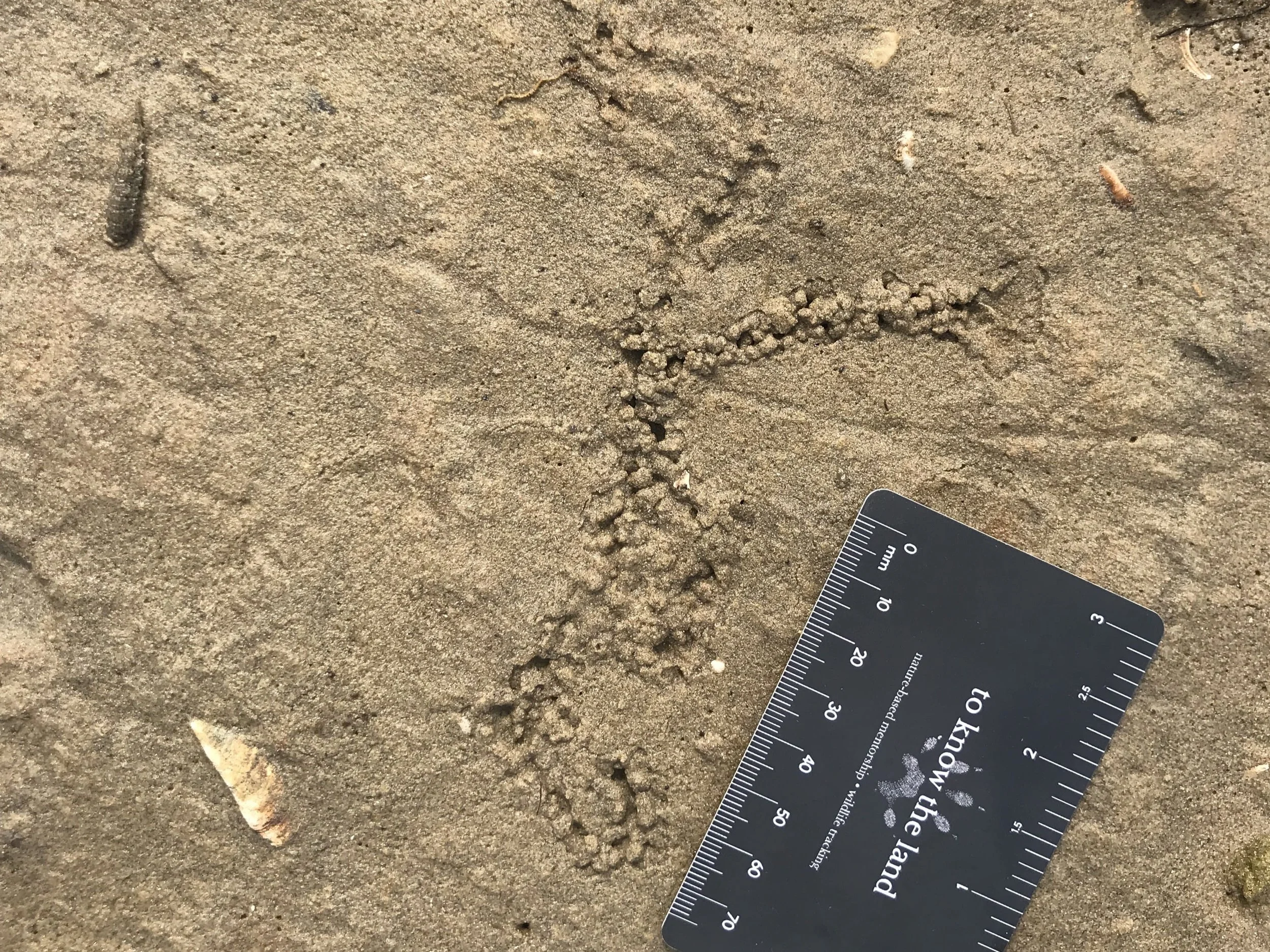
There was a resemblance of the trail we found to the Variegated Mud-loving Beetle (Heteroceridae family) trail in an image in the Tracks and Sign of Insects book on page 491, but I can’t find any other images of their trails online, nor an image of any Heteroceridae larva to back it up. I ended up posting the images above on /r/whatsthisbug to try and find any leads, and /u/Hydropsychidae (named after caddisflies) commented that it was the larva of a Soldier Fly (Stratiomyidae family). I immediately looked it up and it seems correct. In Eiseman and Charney (2010) they write that Soldier Fly larvae will leave meandering trails on the surface of fine, muddy silt in shallow water. There is no photograph of the trail included in the description, but other photos online of the larva themselves looks pretty right on. I have read of them that they are baseball bat shaped, in that the head and thorax are wider than the thin “tail” end of the abdomen. There is a lot to know about Soldier Fly’s and I am learning a lot from my research. First, they are flies, in the Diptera order meaning they have two wings (‘di’ meaning two, and ‘ptera’ meaning wing) and that there are some 178-250 species (depending on the resource I am reading from) of Soldier Fly on Turtle Island/North America. In A Guide to Common Freshwater Invertebrates of North America, J. Reese Voshell writes about Soldier Fly larva hanging out near rivers, ponds, swamps and even sewage discharges. They are somewhat to very tolerant of pollution and some larva are aquatic, some semi. Some species are reared for food for both livestock and humans, and this is something I would like to look into a little bit more.
It is likely that the species we found is in the genus Stratiomys. I ended up posting the photo above on inaturalist with the suggestion of Stratiomys as the genera and another user confirmed the i.d. I then looked up the user and it turns out he works as a taxonomist with a special interest in Stratiomyidae! Inaturalist is a very useful resource. I would suggest looking using the website/app, especially for difficult i.d.’s like insect larva.
We kept on with our day, meaning we walked another 10 meters or so and then stopped again to admire another trail.
The trail could be described as alternating patterns of two rows of dots laid atop one another. We interpreted this as a front foot landing and then a hind foot. But which was which? And which way was the animal going? And who was this animal?
When I see a trail like this, a trail that does not widen or narrow along the entirety of the length we can see, as I did with the crayfish, I immediately think of a body that has a fixed width, or at least has parts of the body that cannot get any narrower or wider regardless of how fast or slow they are going. Alastair measured the trail width at about 20 cm (~8 in). This is wider than any invertebrate that I know of and must denote another, larger species. I think we all understood almost right away that this was a trail left by a turtle. Their spines cannot flex and they cannot narrow or widen their trail widths. But which turtle was it? There are records of Common Snapping Turtles, Midland Painted Turtles (Chrysemys picta ssp. marginata), Spotted Turtles (Clemmys guttata), Wood Turtles (Glyptemys insculpta), and there may be Blanding’s Turtles (Emydoidea blandingii) and maybe Northern Map Turtles (Graptemys geographica) in the area. All of these turtles but one are too small to make such wide of a trail. The Midland Painted Turtles trail widths according to Filip Tkaczyk in his book Tracks and Sign of Reptiles and Amphibians are 10.16 - 16.76 cm (4 - 6.6 in), which is too small for the trail we found. The Common Snapping Turtle trail width is 20.32 - 26.67 cm (8 - 10.5 in) which fits well for our trail we found. I do not have the numbers for the trail widths on any of the other species listed above, but I am fairly certain that the Snapper is the largest turtle in the area, so the trail is likely from a Snapping Turtle. I don’t remember if there was a tail drag or not, but the presence of a tail drag can help with the identification, as well as the plastron drag. The plastron is the bottom part of the turtles shell on the underside of the turtle. Some turtles drag their plastrons, while others tend to lift theirs off of the ground when they walk. Painted Turtles have a relatively wide plastron that often drags when they walk, where as the Snapping Turtle raises their body as they walk and the plastron does not show until moving through deeper substrates or when coming to a stop. Again, as we saw no evidence of a plastron drag this too points to a Snapping Turtle.
Now, more questions. What was the direction of travel, towards or away from the water, and how do we know?
Snapping Turtles have 5 toes on the front feet and all of them tend to show up in ideal substrates. They also have some big long and thick claws which really dig into the sand or mud or other substrates you find them in. Front tracks also tend to be turned toward the center of the animal/trail at about a 45° angle, which makes it easier, sometimes, to figure out fronts from hinds. The hind tracks also have 5 toes, but usually only 4 of the toes register. The hind tracks do not turn inward in that same 45° angle as the fronts do, but instead face forward towards the direction of travel. Alastair took the time to describe the trail in detail for all of us noting exactly this, that the front foot claws were angled towards the center of the trail, and that the rear foot would be pointing in the direction of travel, which meant the Snapping Turtle was walking up and out of the water towards the higher vegetated ground.
We sat down for lunch around the spot of the Snapping Turtle and watched a Ring-billed Gull (Larus delawarensis) make some tracks as we ate and then moved on.
I have to admit that we saw a lot more stuff, fascinating discoveries, each one deserving their own lengthy blogpost but I look at my calender and see that with another tracking weekend coming up in only a few short days, I feel like this one needs to be brought to a close. Perhaps someday I’ll get back to some of the other things we saw but for now this is the end.
Now I just can’t wait to get back to Saugeen to see what new we’ll find next time.
p.s. Did you know that you can estimate the age of a fish from counting the growth rings on their scales? Similar to trees in cooler climates, fish grow slower in the winter and the growth rings show up closer together and create the appearance of a thicker or darker ring. These thick or dark “winter rings” can be counted to determine a fish’s age! Now I have to start looking at scales as well as teeth.
To learn more :
Bird Tracks and Sign by Mark Elbroch and Eleanor Marks. Stackpole Books, 2001.
Bird Tracks by Jonathan Poppele. Adventure Publications, 2023.
Freshwater Fishes of Ontario by Erling Holm, Mary E. Burridge, and Dr. Nicolas E. Mandrak. ROM, 2010.
Pharyngeal Teeth video by Timothy Spier
FishBase entry on Cyprinus carpio
Tracks and Sign of Insects and Other Invertebrates by Charley Eiseman and Noah Charney. Stackpole Books, 2010.
Tracks and Sign of Reptiles and Amphibians by Filip Tkaczyk. Stackpole Books, 2015.
A Guide to Common Freshwater Invertebrates of North America by J. Reese Voshell, Jr. The McDonald & Woodward Publishing Company, 2002.





